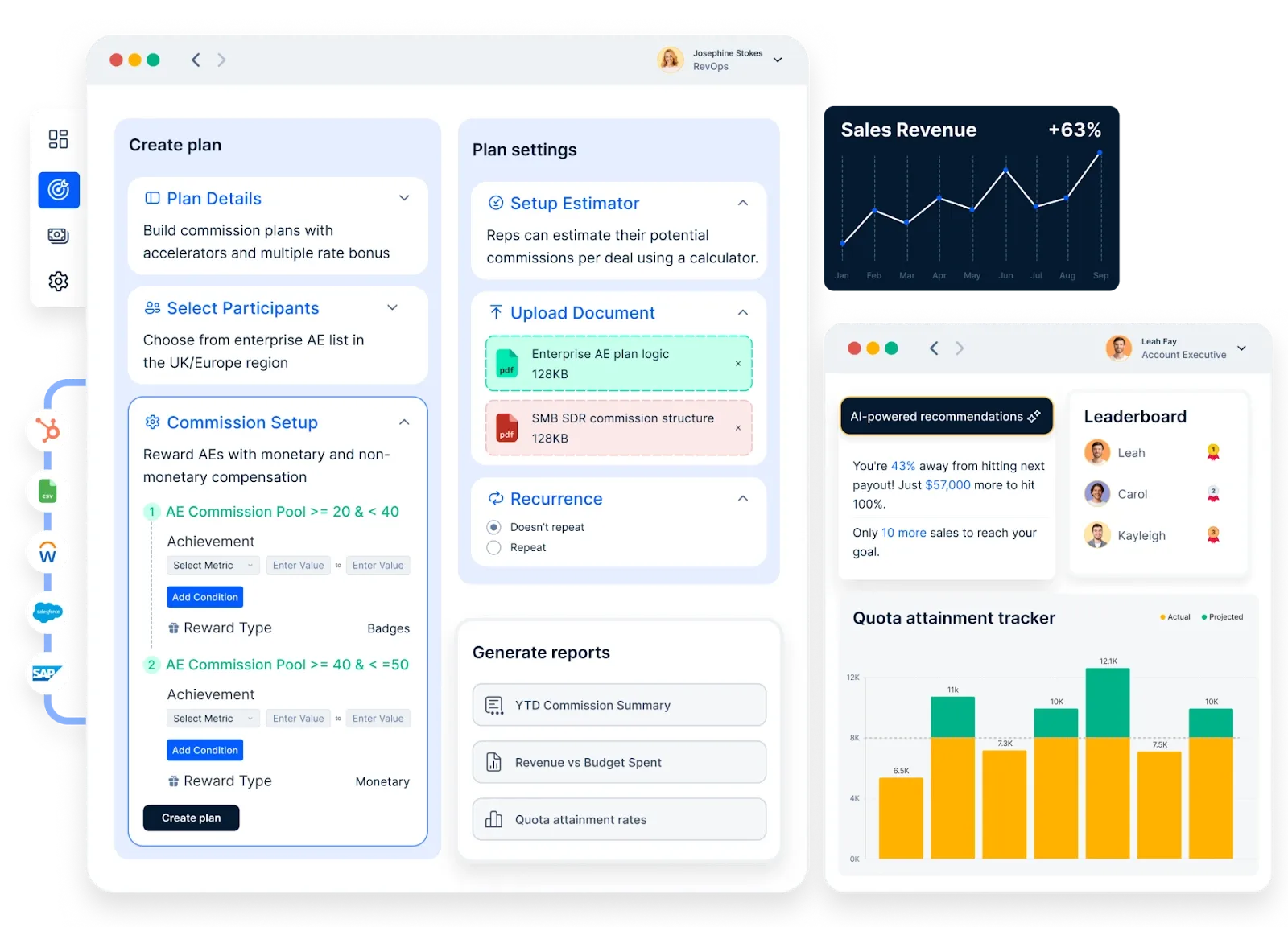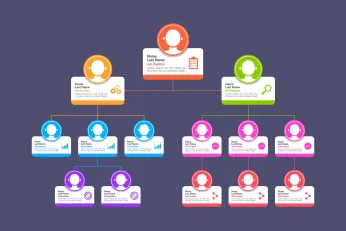SDR Compensation Plan: How to Create an Effective Plan with Example
Know how to design successful SDR compensation plans with our step-by-step guide. Explore strategies to motivate your sales team.
On this page
Sales development representatives (SDRs) are the most important pillar of the sales team. They are responsible for producing leads and ensuring the sales queue is always full. Focused on preliminary outreach, lead eligibility checks, and early-stage client interaction, sales development representatives play a crucial role in turning prospective leads into sales possibilities.
However, businesses must create an appropriate compensation plan that motivates employees to achieve revenue targets, thereby promoting optimal performance. In addition to increasing productivity, well-designed SDR comp plans also promote retention by giving SDRs a sense of financial security and dignity.
The average base salary in San Francisco is $67,050, with an additional cash compensation of $26,677, bringing the total compensation to $93,727. This attractive wage structure reflects the high demand for competent SDRs fast-paced job market, providing both stability and performance-based incentives.
In this blog post, we will learn how to create an effective compensation plan by knowing its components, performance indicators, common problems, and solutions for creating a successful SDR compensation plan.
This information will help you create an SDR comp plan that will support your organization's expansion objectives while guaranteeing equity and rewarding performance.
Understanding SDR roles and responsibilities
Understanding the special roles of SDRs and how they fit into the entire sales funnel is crucial for developing a really effective pay plan. SDRs don't close deals, in contrast to typical salesmen. Rather, they concentrate on:
- Prospecting: The process of identifying and communicating with possible clients through research.
- Cold outreach: Contacting possible leads via cold calling or sending emails.
- Lead qualification: Assessing a lead's potential as a sales prospect.
- Making appointments: Scheduling meetings or product demonstrations for sales agents to attract more potential customers.
- Monitoring inbound leads: This involves contacting leads who have expressed interest in doing business with the organization, usually through marketing campaigns or website inquiries.
Due to the nature of their work, SDRs are in charge of qualifying leads, meeting important performance indicators, and developing connections with prospects in the early phases of the sales process.
Key components of an SDR comp plan
Now let us know the key components of an SDR comp plan that helps to motivate the employees.
- Base pay: This is the set portion of the compensation plan that provides the SDR with financial stability. Since SDRs typically work in entry—or mid-level positions, the base pay should be enough to cover their expenses while allowing them to concentrate on their work without interruption. Usually, between 60% and 70 % of an SDR's total income is generated by their base pay.
- Pay/commission variable: The variable component needs to provide incentives based on the achievement of predetermined benchmarks, including the overall number of scheduled meetings or qualified leads produced. Numerous key performance indicators (KPIs) that support the business's overall sales strategy can be associated with variable pay. Variable compensation often accounts for 30–40% of total earnings in SDR comp plans.
- On-target earnings (OTE): OTE, or expected total earnings, is a composite of base pay and variable compensation that represents what an SDR will get upon meeting all performance goals. To prevent misunderstandings and guarantee that SDRs are aware of their responsibilities to optimize their profits, OTE should be explained clearly.
- Rewards and bonuses: Incentives, along with base pay and commission, can be a very effective technique for boosting SDR motivation. One-time bonuses for surpassing goals or hitting important benchmarks, like finding a high-quality lead, could fall under this category. To promote teamwork, bonuses may also be applied for team-wide accomplishments.
- Ramp period: New SDRs can take some time to catch up. At this ramp-up phase, the organization can provide an assured minimum commission or incentive structure, giving SDRs time to adjust without the immediate stress of hitting large targets.
Here is an example, which will help you to understand all the components clearly.
Additionally, XYZ Corp provides incentives, including a three-month bonus for team-wide achievement milestones and an additional $1,000 for every five extra meetings beyond her objective. Jane has a ramp period for the first three months in which, even if she doesn't hit her quotas, she is assured a $5,000 commission to help her transition to the new post.
How to design a balanced compensation plan?
A balanced compensation plan for a Sales Development Representative (SDR) typically combines both fixed and variable pay. The variable portion is tied to key performance indicators (KPIs) to ensure that performance aligns with company goals.
For example, an SDR named John has a monthly salary of $3,000 as his fixed base pay. His variable pay is an additional $1,500, which is tied to the following KPIs:
- Number of qualified leads: 40% of the variable pay. If John generates 20 qualified leads in a month, he earns $600. If he exceeds this target, say by generating 25 leads, he earns more, but if he only generates 15 leads, he earns less.
- Call activity: 30% of the variable pay. John needs to make 100 calls a week. If he reaches this target consistently throughout the month, he earns $450. If he exceeds his call target, he can potentially earn more, but missing the target reduces his earnings.
- Conversion rate: 30% of the variable pay. John is expected to convert 10% of his leads into opportunities. If he meets this goal, he earns $450. Again, exceeding this rate boosts his earnings, while underperformance lowers it.
In this compensation plan, John’s variable pay is directly linked to his performance, and the fixed salary ensures financial stability. This balance helps keep him motivated while aligning his efforts with the company’s sales objectives. Here is a sample commission structure in table format based on the KPIs of an SDR:
KPI | Weightage | Target | Commission per KPI | Commission structure |
Qualified Leads | 40% | 20 qualified leads per month | $600 | - Meets target (20 leads): $600 |
Call Activity | 30% | 400 calls per month (100/week) | $450 | - Meets target (400 calls): $450 |
Conversion Rate | 30% | 10% conversion from leads to opps | $450 | - Meets target (10%): $450 |
The SDR's total variable pay of $1,500 is distributed across three KPIs: Qualified Leads, Call Activity, and Conversion Rate. Each KPI has a set weightage, indicating its impact on the total variable pay:
- Qualified leads: If the SDR meets or exceeds the target (20 leads), they will earn the corresponding commission. For underperformance, they receive less commission.
- Call activity: The number of calls directly influences the commission. Consistent weekly targets ensure steady progress toward monthly goals.
- Conversion rate: The percentage of leads converted into opportunities determines how much of the commission they earn. Higher conversion rates result in higher commissions.
This structure ensures that each performance metric is rewarded individually, and the SDR has clear financial incentives to perform across all KPIs.
In addition to rewarding individual achievement, well-crafted SDR comp plans should promote long-term career advancement. Have a look at these steps to develop a plan that produces intended outcomes:
1. Start with SDR on-target earnings
On-target earnings (OTE) refer to the total expected earnings of an SDR if they meet 100% of their performance targets. It includes both base salary and variable pay. Companies use this metric to communicate salary expectations for roles with a commission component.
When structuring an SDR compensation plan, begin by defining the OTE. This approach ensures fairness, competitiveness, and budget alignment. Setting OTE first allows you to work backward to create a sustainable pay structure.
Key metrics to consider:
- Average contract value: How much is an average customer worth to your business? Consider deal size and contract length to determine a reasonable budget for acquiring new customers.
- Expected outcomes and conversion rates: If you have an SDR team, analyze their historical performance to estimate how many deals they generate annually and the activities needed to reach that goal.
- Revenue targets: What is your leadership team’s revenue expectation from the SDR team?
In many companies, SDRs contribute 30% to 40% of new business revenue. For example, if your company aims to generate $12 million in new revenue, SDRs should bring in about $3.6 million. If you have 12 SDRs, each will need to generate approximately $300,000 annually.
A typical quota-to-OTE ratio falls between 5:1 and 8:1. Using this guideline, an SDR's OTE should range between $37,500 and $60,000, aligning with industry standards. However, these numbers should be adjusted based on company size, team structure, product pricing, and other relevant factors.
2. Define the pay mix
For entry-level sales roles, base salary typically makes up a larger portion of the compensation structure. A higher base salary provides stability while SDRs develop their skills. The most common base-to-variable pay mix for SDRs ranges between 50/50 and 70/30.
The best SDR comp plans strike a balance—allowing SDRs to sustain themselves on their base salary while ensuring that commissions remain a motivating factor. If the base salary is too high, SDRs may lack the drive to hit their targets. If it’s too low, retention can become a challenge.
3. Choose commission structure: Activities vs. outcomes
SDRs typically earn commissions based on either activities or outcomes. A well-balanced plan often incorporates both.
- Activity-based compensation: SDRs receive a set amount for specific tasks such as calls made, meetings booked, or inbound lead response times. This model works well since SDRs do not close deals directly.
- Outcome-based compensation: SDRs earn a percentage of sales from deals they originated. This encourages them to focus on high-quality leads but can be frustrating when closing power is out of their hands.
A hybrid approach prevents extreme scenarios where SDRs focus only on volume (if paid on activities) or get discouraged by uncontrollable factors (if paid solely on outcomes). The key is to align incentives with behaviors that drive revenue.
4. Different compensation for outbound vs. inbound SDRs
Outbound and inbound SDRs perform different roles and should have compensation structures that reflect their responsibilities.
- Outbound SDRs: Their focus is cold outreach, so key performance indicators (KPIs) may include the number of cold calls, meetings booked, or personalized emails sent.
- Inbound SDRs: Since they qualify and manage leads from marketing efforts, their KPIs may include response time or the number of qualified meetings booked.
A strong SDR compensation plan should map out the sales process from the first touchpoint to a closed deal. By understanding how many activities lead to a single sale, you can create a plan that motivates and rewards SDRs effectively.
Any organization can notice a streamlined payout in their comp plan if done well.
They implemented Compass to automate commission processes, provide real-time visibility, and boost sales rep engagement through gamification.
In less than 90 days, the firm saw 68% adoption of Compass, a 36% increase in payouts, and a 34% rise in incentive qualifiers as implementing Compass streamlined their compensation and helped in:
- Implementation of a centralized platform: Compass provided a centralized platform that automated many aspects of the compensation planning process.
- Data integration: The platform integrated various data sources, ensuring that all relevant information was readily available and accurate.
A good SDR compensation plan should benefit both the individual SDR and the company. It's important to design a plan that is both realistic and easy to understand to keep morale high and ensure more deals are closed. Most companies use a variable compensation SDR plan, which includes a base salary plus commission based on how well the SDR performs.
SDR comp plans examples
Here are a couple of SDR comp plans to show the differences between inbound and outbound SDR roles.
1. Outbound sales development rep
Category | Metric | Commission/Incentive |
Base Compensation | Base Salary | $32,500 per year |
On-Target Earnings | OTE (Base + Commission) | $65,000 per year |
Activity Volume | Meaningful Touches (1000+) | $400 |
Meaningful Touches (750+) | $200 | |
Meaningful Touches (Under 750) | $0 | |
Meeting Quality | Accepted Meetings (6+) | $100 per accepted meeting |
Accepted Meetings (11+) | $250 per accepted meeting | |
Revenue Impact | Closed-Won Revenue Generated | 2% of all closed-won revenue booked by the SDR |
Overall Goals | Monthly Meaningful Touches | 750 |
Monthly Accepted Meetings | 10 | |
Monthly Closed-Won Revenue Target | $75,000 |
2. Inbound sales development rep
Category | Metric | Commission/Incentive |
Base Compensation | Base Salary | $39,000 per year |
On-Target Earnings | OTE (Base + Commission) | $65,000 per year |
Lead Response | Response Time (Under 5 minutes) | $500 per lead |
Response Time (Under 10 minutes) | $250 per lead | |
Response Time (Over 10 minutes) | $0 | |
Opportunity Quality | Qualified Opportunities (5+) | $150 per qualified opportunity |
Qualified Opportunities (9+) | $250 per qualified opportunity | |
Revenue Impact | Closed-Won Revenue Generated | 1% of all closed-won revenue booked by the SDR |
Overall Goals | Monthly Qualified Opportunities | 8 |
Monthly Closed-Won Revenue Target | $60,000 |
Ace creating SDR compensation plan with Compass

An SDR comp plan that integrates individual objectives with corporate objectives and strikes a balance between base pay and performance-based incentives is considered efficient.
Businesses can design a system that fosters business expansion by establishing clear goals, providing competitive remuneration, and routinely assessing the strategy.
Keep in mind that maintaining a comp plan that produces results while your company grows requires transparency and adaptability. This is where Compass can help you. Here are some key ways Compass can assist with SDR compensation plans:
- Compass allows you to design commission plans for any KPI or metric with just a few simple clicks. You can easily handle accelerators, tiers, and workflow triggers without writing any code.
- The platform automates commission calculations to arrive at error-free payouts for your SDRs. It eliminates manual work and ensures accurate commissions every time.
- Compass provides SDRs with real-time visibility into their pipeline, accrued commissions, predictions, and more. Leadership teams also get full visibility into performance and payouts across the organization.
Schedule a call with the experts at Compass to learn how Compass can streamline your business.
FAQs
1. What does OTE mean in terms of SDR pay?
The total remuneration that SDRs can expect if they fulfill all of their performance goals is known as On-Target Earnings (OTE). It usually consists of base pay plus commission.
2. How is the SDR commission calculated?
Indicators like scheduled meetings or qualifying leads frequently determine commission for SDRs. One popular formula that adds to the variable pay is to award a commission rate on each qualified lead or meeting.
3. What proportion of base salary should make up SDR compensation?
In an average SDR compensation plan, base pay makes up 60–70% of total wages, with variable pay based on performance accounting for the remaining 30–40%.
4. How should SDRs be compensated?
SDRs should have a mix of base salary and variable compensation. A typical SDR compensation plan includes a base salary (around 50-70% of total earnings) and performance-based incentives tied to key metrics like qualified opportunities, meetings set and closed-won revenue.
5. What is the compensation plan for SDR managers?
SDR managers usually have a higher base salary than SDRs, with on-target earnings (OTE) ranging between $90,000 to $140,000. Their variable compensation is often based on team performance, including quota attainment, revenue impact, and SDR retention.
6. What is the average commission structure for SDRs?
The SDR commission structure varies but typically includes:
- A base salary of $40,000 to $60,000
- Commission based on meetings booked, opportunities created, or revenue closed
- Percentage-based commission (e.g., 1-3% of closed-won revenue)













